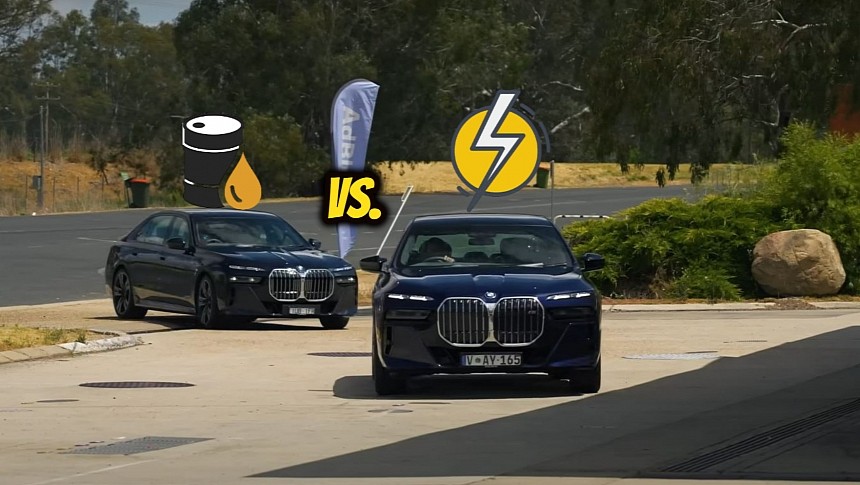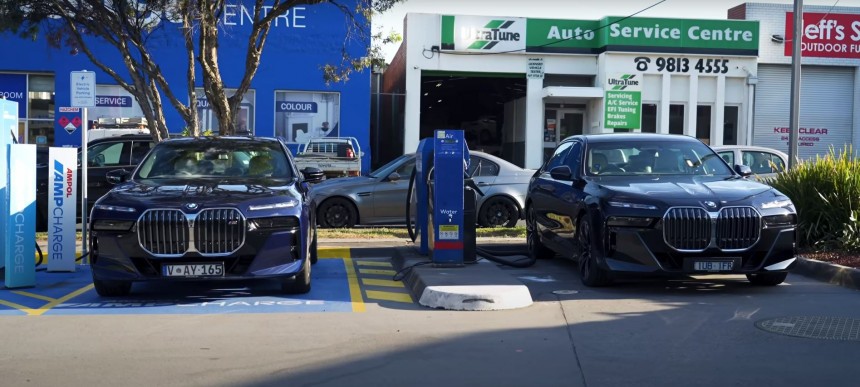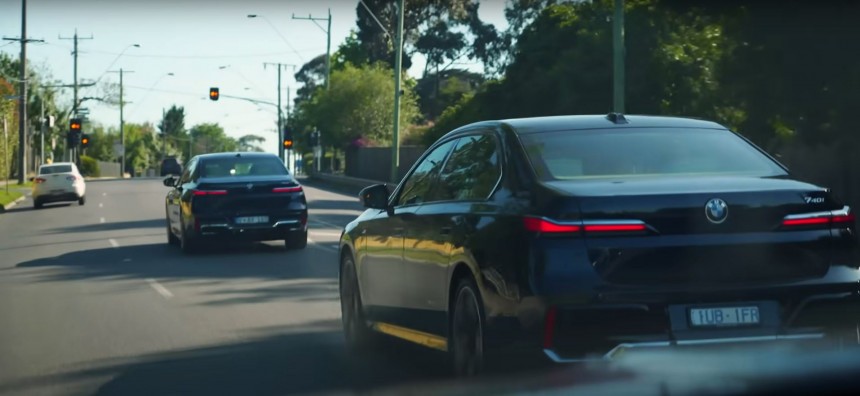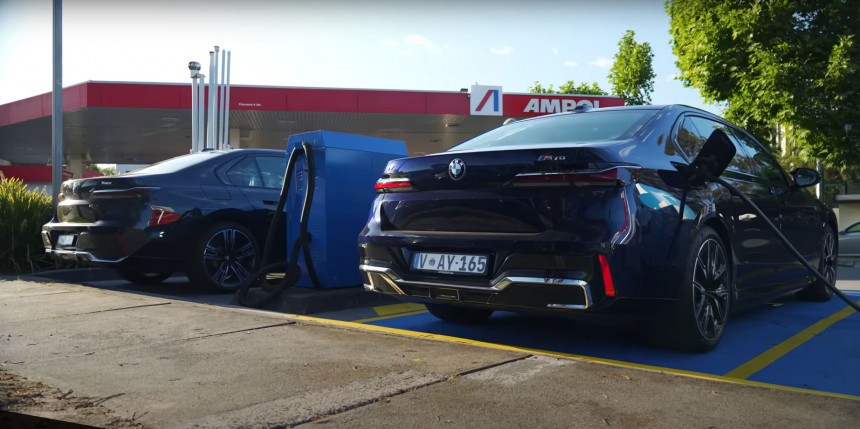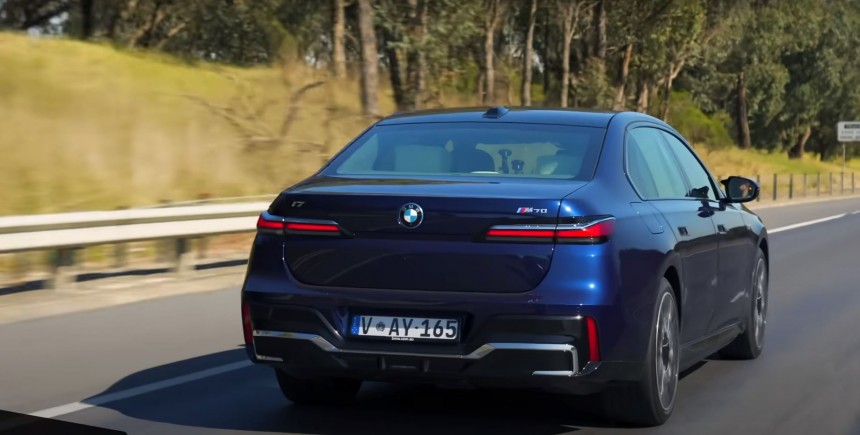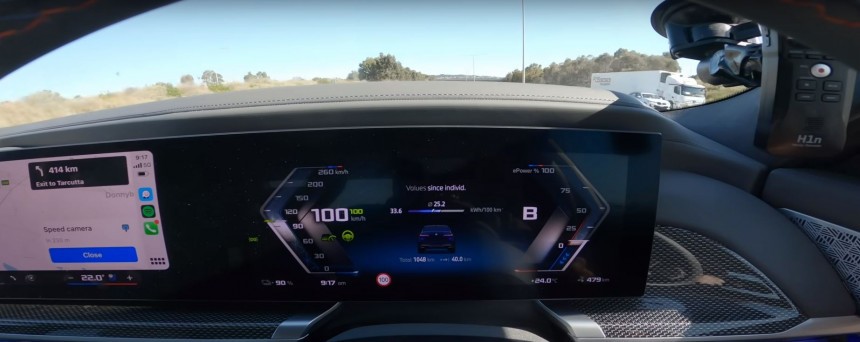In the beginning, we were told that switching to electric vehicles (EVs) would be the right thing to do for the environment. Then, incentives and fights followed. Now, we have plenty of options and have become picky. But are EVs going to take us where we want to go? Here's a practical answer.
There's no better way to prove that all-electric cars have reached maturity than by putting them against an equal rival powered by fossil fuels. The BMW i7 M70 and the BMW 740i go for a 540-mile trip down under from Melbourne to Sydney. One comes on top and is not the one you might be rooting for.
Let's meet the cars first.
The 2024 BMW 740i is a rear-wheel-drive sedan with a starting MSRP of $96,400. It's powered by the acclaimed 3.0-liter six-cylinder engine known as the B58 by fans and enthusiasts. It's a great powerplant that can be tuned easily without compromising its integrity. The fact that BMW put it under the hood of its flagship is just another confirmation that the mechanical beating heart is a winner.
But from the factory, this turbocharged six-cylinder puts out 375 hp. Sending all that power to the rear wheels only results in a potent yet tempered acceleration from zero to 60 mph in 5.2 seconds.
On the other side of the aisle, there's the clean version of the Bavarian Rolls Royce-y monolith. It's an all-wheel-drive powerhouse that will set you back at least $168,500 before any taxes, fees, and incentives. But that gets you a lush machine that can sprint from zero to 60 mph in just 3.5 seconds. Going from meeting to meeting is going to be much easier, quicker, and quieter.
The Aussie CarExpert team thought about eliminating that discrepancy by adding artificial weight to the 740i. However, they didn't go through with it because the payload of the gas-powered sedan was 1,532 lb (695 kg), and that would have meant picking another driver.
Looking at official data, the Environmental Protection Agency (EPA) says the i7 M70 can do 291 miles (468 km) on a single charge.
On the other hand, the 740i consumes 3.6 gallons of gas per 100 miles, resulting in a maximum go ability of around 542 miles (872 km). It's important to keep in mind that BMW adopted a smart approach with EV range and fuel economy. Its newer cars almost always do noticeably better in a real-world environment than in the EPA's lab. It's always better to underpromise and overdeliver, so that's a green star from us!
Now, onto the test.
The EV was charged to 100%, and the ICE-powered sibling was filled to the brim. Each sedan had one driver in them.
However, given the added weight of the battery pack, the dual-motor drivetrain, and the stiffened suspension, the i7 M70 was at a clear disadvantage from the get-go.
Still, we're making no excuses for the EV. It's just necessary to point out the differences. A fairer test would have put the i7 M70 against the 760i xDrive. Similarly, the team could have also picked the rear-wheel-drive i7 eDrive50 to fight the 740i.
The i7 M70 driver spent AUD 132 (USD 87) on fast charging, while the 740i driver topped off the sedan's gas tank for AUD 118 (USD 78). Traveling 542 miles with the gas-powered 7 Series was cheaper, but that's not the only advantage of sticking with burning fossil fuels. The other one is time.
The i7 M70 needed at least one long stop or two slightly shorter breaks to replenish its high-voltage energy storage unit, whereas the 740i was able to do the entire journey without needing any extra gas.
In reality, the EV prolonged the 542-mile trip by about two hours. The ICE-powered car needed just five minutes at a gas station. In the world of people who need or want this type of vehicle, time might be an important resource that matters more than not releasing emissions into the air.
It's also worth noting that both cars were driven at the posted speed limit (68 mph/110 kph) along the way, with the A/C on and in Comfort Mode. There was no hypermiling involved!
The driver could have fast-charged twice along the route and would have cut in half the time spent plugged in. No matter the EV of choice, every single one that's on the market today will throttle fast charging above the 80% state of charge.
Besides that, there's also the charging curve to keep in mind. As the battery gets filled up with electrons, the speed at which it pulls electricity from the dispenser decreases. You really don't want to wait at a DC fast charger until the energy storage unit is at 100% because you would be wasting time.
It's also not recommended to do so because it could accelerate the wear of the cells. That's true only if your EV doesn't have a lithium iron phosphate (LFP) battery. The i7 uses a lithium nickel manganese cobalt (NMC) high-voltage energy storage unit built on the 400V architecture. As such, you (or your driver) may want to avoid overcharging at DC stalls regularly.
Charging at home isn't throttled because it's a linear process that can take anywhere between four hours (with a Level 2 charger) and 57 hours (at a normal house socket).
As for BMW, the i7 is a great sedan for people who enjoy the advantages of electric motoring and can charge at home, at the office, or have access to a network of DC fast charging stations that they use when it's time to leave the proximity of an urban area. It is not an experiment or the product of a lackadaisical approach. It's truly a mean machine that does its best with the technology available today.
Next year, the automaker is bringing forward a brand-new EV platform with new, more efficient motors and better high-voltage batteries. The facelifted i7 could become an undisputed champion.
In conclusion, traveling long distances with an EV can be a little more expensive than filling up with gas. However, that can immediately change if you can charge at home or, better yet, have solar panels on your house.
But if you don't want to complicate your life with installing a solar roof, Level 2 chargers, and playing with various charging apps while away from home, the good ol' gas-powered car remains the obvious choice. Fuel is cheap right now (except in Europe), and the downtrend could continue.
Governments around the world may plan to ban the sale of internal combustion engine-powered cars in 2030 or 2035, but it'll be a while before we'll all sit behind the steering wheel of a battery- or hydrogen-powered ride. Pick what you can afford and like, and have at it with it!
The winner is you, the consumer. Drive safe!
Let's meet the cars first.
The 2024 BMW 740i is a rear-wheel-drive sedan with a starting MSRP of $96,400. It's powered by the acclaimed 3.0-liter six-cylinder engine known as the B58 by fans and enthusiasts. It's a great powerplant that can be tuned easily without compromising its integrity. The fact that BMW put it under the hood of its flagship is just another confirmation that the mechanical beating heart is a winner.
But from the factory, this turbocharged six-cylinder puts out 375 hp. Sending all that power to the rear wheels only results in a potent yet tempered acceleration from zero to 60 mph in 5.2 seconds.
More than meets the eye
Even though it doesn't release any emissions into the air, the EV weighs quite a lot more than its internal combustion engine-powered counterpart – 1,334 lb (605 kg), to be precise.The Aussie CarExpert team thought about eliminating that discrepancy by adding artificial weight to the 740i. However, they didn't go through with it because the payload of the gas-powered sedan was 1,532 lb (695 kg), and that would have meant picking another driver.
Looking at official data, the Environmental Protection Agency (EPA) says the i7 M70 can do 291 miles (468 km) on a single charge.
On the other hand, the 740i consumes 3.6 gallons of gas per 100 miles, resulting in a maximum go ability of around 542 miles (872 km). It's important to keep in mind that BMW adopted a smart approach with EV range and fuel economy. Its newer cars almost always do noticeably better in a real-world environment than in the EPA's lab. It's always better to underpromise and overdeliver, so that's a green star from us!
Controlled explosions versus electricity
The pair started in Melbourne and wanted to arrive in Sydney. That meant traveling mostly on highways for a total distance of about 542 miles (873 km).The EV was charged to 100%, and the ICE-powered sibling was filled to the brim. Each sedan had one driver in them.
However, given the added weight of the battery pack, the dual-motor drivetrain, and the stiffened suspension, the i7 M70 was at a clear disadvantage from the get-go.
Still, we're making no excuses for the EV. It's just necessary to point out the differences. A fairer test would have put the i7 M70 against the 760i xDrive. Similarly, the team could have also picked the rear-wheel-drive i7 eDrive50 to fight the 740i.
The i7 M70 driver spent AUD 132 (USD 87) on fast charging, while the 740i driver topped off the sedan's gas tank for AUD 118 (USD 78). Traveling 542 miles with the gas-powered 7 Series was cheaper, but that's not the only advantage of sticking with burning fossil fuels. The other one is time.
In reality, the EV prolonged the 542-mile trip by about two hours. The ICE-powered car needed just five minutes at a gas station. In the world of people who need or want this type of vehicle, time might be an important resource that matters more than not releasing emissions into the air.
It's also worth noting that both cars were driven at the posted speed limit (68 mph/110 kph) along the way, with the A/C on and in Comfort Mode. There was no hypermiling involved!
But wait, there's more!
The EV driver arrived at the first charging station with the 105.7-kWh (gross) battery at 2%. Instead of charging until 80% (which would have taken around 35 minutes), he chose to wait until 100%. That took almost 70 minutes.The driver could have fast-charged twice along the route and would have cut in half the time spent plugged in. No matter the EV of choice, every single one that's on the market today will throttle fast charging above the 80% state of charge.
It's also not recommended to do so because it could accelerate the wear of the cells. That's true only if your EV doesn't have a lithium iron phosphate (LFP) battery. The i7 uses a lithium nickel manganese cobalt (NMC) high-voltage energy storage unit built on the 400V architecture. As such, you (or your driver) may want to avoid overcharging at DC stalls regularly.
Charging at home isn't throttled because it's a linear process that can take anywhere between four hours (with a Level 2 charger) and 57 hours (at a normal house socket).
Unpacking what matters most
So, what's the lesson here? Well, EVs are still not fit for simple, headache-free road-tripping. They can also incur more expenses, even in countries like Australia. The winter weather some Americans experienced recently also showed that most people aren't ready to control an EV and rely too much on an infrastructure that can't serve everyone – for now. They didn't know that the cold can cut the range by 30, 40, or even 50% and didn't learn that it's better to charge at home a little or precondition the battery before plugging into a DC dispenser.Next year, the automaker is bringing forward a brand-new EV platform with new, more efficient motors and better high-voltage batteries. The facelifted i7 could become an undisputed champion.
In conclusion, traveling long distances with an EV can be a little more expensive than filling up with gas. However, that can immediately change if you can charge at home or, better yet, have solar panels on your house.
But if you don't want to complicate your life with installing a solar roof, Level 2 chargers, and playing with various charging apps while away from home, the good ol' gas-powered car remains the obvious choice. Fuel is cheap right now (except in Europe), and the downtrend could continue.
Governments around the world may plan to ban the sale of internal combustion engine-powered cars in 2030 or 2035, but it'll be a while before we'll all sit behind the steering wheel of a battery- or hydrogen-powered ride. Pick what you can afford and like, and have at it with it!
The winner is you, the consumer. Drive safe!
